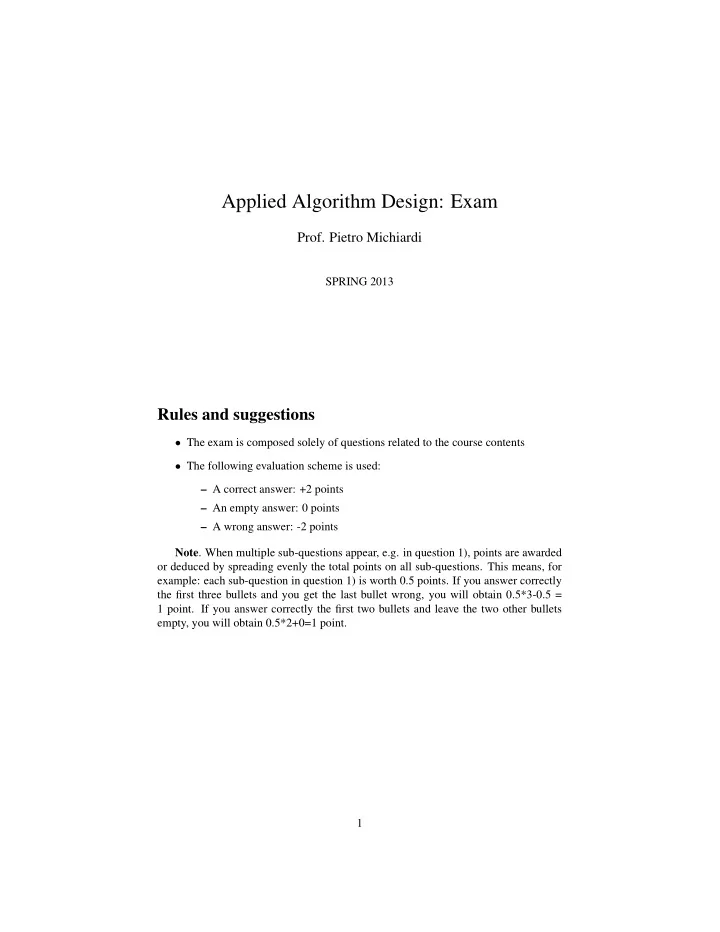

Applied Algorithm Design: Exam Prof. Pietro Michiardi SPRING 2013 Rules and suggestions • The exam is composed solely of questions related to the course contents • The following evaluation scheme is used: – A correct answer: +2 points – An empty answer: 0 points – A wrong answer: -2 points Note . When multiple sub-questions appear, e.g. in question 1), points are awarded or deduced by spreading evenly the total points on all sub-questions. This means, for example: each sub-question in question 1) is worth 0.5 points. If you answer correctly the first three bullets and you get the last bullet wrong, you will obtain 0.5*3-0.5 = 1 point. If you answer correctly the first two bullets and leave the two other bullets empty, you will obtain 0.5*2+0=1 point. 1
Questions 1. The Gale-Shapley algorithm . Please, answer the following questions: • What is the best data structure to store men, women, and their respective preference lists? Please, simply name the data structure. • What is the best data structure to store the list of free men, that appear in the main while loop of the algorithm? Please, simply name the data structure. • Given the above selection of data structures, what is the worst-case running time of the Gale-Shapley algorithm? Please, simply use the O () notation. • Why is it important for the Gale-Shapley algorithm to output the same re- sult no matter what the proposal order is? Please, be brief. 2. Give an example of an algorithm for each of the following worst case running times. Please, be brief; well-known and simple algorithms are accepted as good answers to the question. • O ( n ) : linear running time • O ( n log n ) • O ( n 2 ) : quadratic running time 3. Graph traversal . Please, name an algorithm to find, given an undirected graph G = ( V, E ) , if there exist a path from s ∈ V to t ∈ V . A pseudo-code for the algorithm is not necessary for a correct answer. 4. Given an undirected graph G = ( V, E ) , name a simple algorithm to check for bipartiteness. A pseudo-code for the algorithm is not necessary for a correct answer. 5. Please, define and explain (in a few bullets) the pros and cons of the two follow- ing data structures to store a sparse graph G = ( V, E ) : • Adjacency matrix • Adjacency list 6. Name and explain (in a few bullets) an important feedback centrality index we studied in class. Please, answer briefly 7. The PageRank Algorithm . Draw a simple (e.g. 5 nodes) graph, and illustrate (in a sequence of graphs) at least two iterations of the PageRank algorithm: in particular, each node in the drawings should indicate what is the current PageR- ank value. 2
8. Data clustering : please, give the pseudo-code of the k -means algorithm applied to data points in a 2-dimensional plane. In doing so, please also clearly formulate the problem statement you are addressing with the k -means algorithm. [ HINT :] look at the questions below, where a short description of a problem statement is given as a starting point. 9. Interval scheduling . We have a set of requests { 1 , · · · , n } where the i -th request corresponds to an interval of time starting at s ( i ) and finishing at f ( i ) . We say that a subset of the requests is compatible if no two of them overlap in time. Please, answer the following questions: • Give the pseudo-code of an algorithm that accepts as large a compatible subset of requests as possible, that is we want an optimal schedule. • Find and disucss the worst-case running time of your algorithm. 10. Load Balancing . We are given a set M = { M 1 , M 2 , · · · , M m } of m machines and a set J = { 1 , 2 , · · · , n } of n jobs, with job j having a processing time t j . Please, answer the following questions: • Give the pseudo-code of an algorithm that assigns each job to one of the machines so that the “load” placed on all machines is optimally “balanced”. • If optimality cannot be achieved, simply state (no proofs are required) what is the approximation quality achieved by your algorithm: please use the α notation, by stating that your algorithm is an α -approximation algorithm. 3
Recommend
More recommend